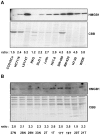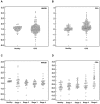Diagnostic significance of serum HMGB1 in colorectal carcinomas
- PMID: 22496788
- PMCID: PMC3319566
- DOI: 10.1371/journal.pone.0034318
Diagnostic significance of serum HMGB1 in colorectal carcinomas
Abstract
High mobility group box 1 protein (HMGB1), a nuclear protein, can be translocated to the cytoplasm and secreted in colon cancer cells. However, the diagnostic significance of HMGB1 has not been evaluated in colorectal carcinomas. For this purpose, we have screened the expression and secretion of HMGB1 in 10 colon cancer cell lines and 1 control cell line and found that HMGB1 was detected in the culture medium. To evaluate the diagnostic value of HMGB1, we performed an enzyme-linked immunosorbent assay to measure HMGB1 levels and compared them to carcinoembryonic antigen (CEA) levels in the serum samples of 219 colorectal carcinoma patients and 75 healthy control subjects. We found that the serum HMGB1 level was increased by 1.5-fold in patients with colorectal carcinoma compared to those in healthy controls. When HMGB1 and CEA levels were compared, HMGB1 had similar efficacy as CEA regarding cancer detection (the sensitivity was 20.1% for HMGB1 vs. 25.6% for CEA, and the specificity was 96% for HMGB1 vs. 90.7% for CEA). Moreover, the diagnostic accuracy of HMGB1 for stage I cancer was significantly higher than that of CEA (sensitivity: 41.2% vs. 5.9%; specificity: 96% vs. 90.7). When we combined HMGB1 and CEA, the overall diagnostic sensitivity was higher than that of CEA alone (42% vs. 25.6%), and the diagnostic sensitivity for stage I was also elevated (47% vs. 5.9%). However, the prognosis of patients was not related with serum HMGB1 concentrations. Our findings indicate that serum HMGB1 levels are increased in a subset of colorectal carcinomas, suggesting their potential utility as a supportive diagnostic marker for colorectal carcinomas.
Conflict of interest statement
Figures




Similar articles
-
Clinical value of serum HMGB1 levels in early detection of recurrent squamous cell carcinoma of uterine cervix: comparison with serum SCCA, CYFRA21-1, and CEA levels.Croat Med J. 2009 Oct;50(5):455-64. doi: 10.3325/cmj.2009.50.455. Croat Med J. 2009. PMID: 19839069 Free PMC article.
-
[Clinical significance of serum high-mobility group box 1 detection in esophageal squamous cell carcinoma].Zhonghua Wei Chang Wai Ke Za Zhi. 2013 Sep;16(9):838-41. Zhonghua Wei Chang Wai Ke Za Zhi. 2013. PMID: 24061989 Chinese.
-
The evaluation of diagnostic value of the tumor markers: CCSA-2 and CEA in colorectal cancer.Pol Przegl Chir. 2012 Feb;84(2):86-92. doi: 10.2478/v10035-012-0014-3. Pol Przegl Chir. 2012. PMID: 22487741 Clinical Trial.
-
Serum Cyr61 as a potential biomarker for diagnosis of colorectal cancer.Clin Transl Oncol. 2017 Apr;19(4):519-524. doi: 10.1007/s12094-016-1560-7. Epub 2016 Oct 14. Clin Transl Oncol. 2017. PMID: 27743169
-
Serum high mobility group box-1 is a powerful diagnostic and prognostic biomarker for pancreatic ductal adenocarcinoma.Cancer Sci. 2012 Sep;103(9):1714-21. doi: 10.1111/j.1349-7006.2012.02358.x. Epub 2012 Jul 30. Cancer Sci. 2012. PMID: 22703527 Free PMC article.
Cited by
-
Translationally controlled tumor protein affects colorectal cancer metastasis through the high mobility group box 1-dependent pathway.Int J Oncol. 2018 Oct;53(4):1481-1492. doi: 10.3892/ijo.2018.4502. Epub 2018 Jul 25. Int J Oncol. 2018. PMID: 30066846 Free PMC article.
-
Relationship between high-mobility group box 1 overexpression in ovarian cancer tissue and serum: a meta-analysis.Onco Targets Ther. 2015 Nov 27;8:3523-31. doi: 10.2147/OTT.S93357. eCollection 2015. Onco Targets Ther. 2015. PMID: 26664135 Free PMC article.
-
Cell Line Secretome and Tumor Tissue Proteome Markers for Early Detection of Colorectal Cancer: A Systematic Review.Cancers (Basel). 2017 Nov 16;9(11):156. doi: 10.3390/cancers9110156. Cancers (Basel). 2017. PMID: 29144439 Free PMC article. Review.
-
Cytosolic high-mobility group box protein 1 (HMGB1) and/or PD-1+ TILs in the tumor microenvironment may be contributing prognostic biomarkers for patients with locally advanced rectal cancer who have undergone neoadjuvant chemoradiotherapy.Cancer Immunol Immunother. 2018 Apr;67(4):551-562. doi: 10.1007/s00262-017-2109-5. Epub 2017 Dec 21. Cancer Immunol Immunother. 2018. PMID: 29270668 Free PMC article.
-
Immunogenic tumor cell death induced by chemoradiotherapy: molecular mechanisms and a clinical translation.Cell Death Dis. 2013 Jun 20;4(6):e688. doi: 10.1038/cddis.2013.207. Cell Death Dis. 2013. PMID: 23788045 Free PMC article. Review.
References
-
- Goodwin GH, Sanders C, Johns EW. A new group of chromatin-associated proteins with a high content of acidic and basic amino acids. Eur J Biochem. 1973;38:14–19. - PubMed
-
- Youn JH, Shin JS. Nucleocytoplasmic shuttling of HMGB1 is regulated by phosphorylation that redirects it toward secretion. J Immunol. 2006;177:7889–7897. - PubMed
Publication types
MeSH terms
Substances
LinkOut - more resources
Full Text Sources
Other Literature Sources
Medical

